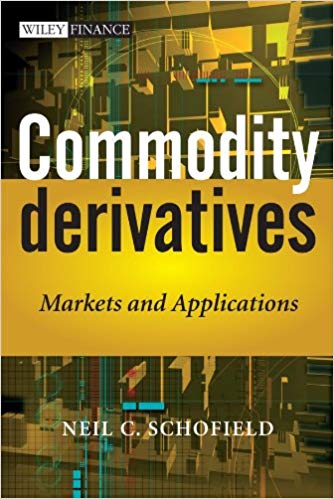(eBook PDF) Commodity Derivatives: Markets and Applications
$50.00 Original price was: $50.00.$35.00Current price is: $35.00.
(eBook PDF) Commodity Derivatives: Markets and Applications – Instant Download
(eBook PDF) Commodity Derivatives: Markets and Applications – Digital Ebook – Instant Delivery Download

Product details:
- ISBN-10 : 0470019107
- ISBN-13 : 978-0470019108
- Author: Neil C. Schofield
In Commodity Derivatives: Markets and Applications, Neil Schofield provides a complete and accessible reference for anyone working in, or studying commodity markets and their associated derivatives. Dealing primarily with over the counter structures, the book provides extensive coverage of both hard and soft commodities, including gold, crude oil, electricity, plastics, emissions and agriculturals. Using structures unique to the individual market, each chapter includes an explanation of the commodity and an analysis of its physical market, discussion on the typical patterns of demand and supply and the main factors that will influence the price of the commodity, and the main products. Each chapter focuses on how the products could be used along the physical supply chain and seeks to identify the main market risks and how they can be hedged. The book then brings into perspective how the structuring banks hedge their own resultant exposure and examines the attraction of OTC investment structures for the wholesale market. Commodity Derivatives: Markets and Applications is essential reading for those wishing to learn about the main features of the commodity markets, the mechanics of derivatives, and how they are applied.
Table contents:
Chapter 1 Fundamentals of Commodities and Derivatives 1
1.1 Market overview 2
1.2 Market participants 3
1.3 Traded versus non-traded commodities 6
1.4 Forward contracts 8
1.5 Futures 8
1.6 Swaps 10
1.7 Options 11
1.8 Exotic options 14
Chapter 2 Derivative Valuation 18
2.1 Asset characteristics 18
2.2 Commodity prices and the economic cycle 18
2.3 Principles of commodity valuation 19
2.4 Forward price curves 21
2.5 Commodity swap valuation 32
2.6 Principles of option valuation 39
2.7 Measures of option risk management 44
Chapter 3 Risk Management Principles 58
3.1 Defining risk 58
3.2 Commodity market participants – the time dimension 60
3.3 Hedging corporate risk exposures 61
3.4 A framework for analysing corporate risk 62
3.5 Hedging customer exposures 63
3.6 Trading risk management 66
Chapter 4 Gold 76
4.1 The market for gold 76
4.2 Gold price drivers 81
4.3 The gold leasing and deposit market 91
4.4 Hedging 96
4.5 Trading gold 106
4.6 Yield enhancement 111
4.7 Summary 112
Chapter 5 Base Metals 114
5.1 Overview of base metal production 114
5.2 The copper lifecycle 115
5.3 Aluminium 119
5.4 The Steel market 120
5.5 The London Metal Exchange 122
5.6 Base metal price drivers 130
5.7 Electric Vehicles 133
5.8 Structure of market prices 134
5.9 Hedges for aluminium consumers in the automotive sector 139
5.10 Summary 157
Chapter 6 Crude Oil 159
6.1 Overview of energy markets 159
6.2 The value of crude oil 159
6.3 An overview of the physical supply chain 163
6.4 Refining crude oil 165
6.5 The demand for and supply of crude oil 172
6.6 Price drivers 179
6.7 The price of crude oil 189
6.8 Trading crude oil and refined products 195
Notes 209
6.9 Managing price risk along the supply chain 212
Chapter 7 Natural Gas 237
7.1 Formation of natural gas 237
7.2 Measuring natural gas 238
7.3 The physical supply chain 238
7.4 Deregulation and re-regulation 242
7.5 The demand for and supply of natural gas 245
7.6 Natural gas prices 250
7.7 Natural gas price drivers 257
7.8 Trading natural gas 260
7.9 Natural gas derivatives 263
Chapter 8 Electricity 280
8.1 What is electricity? 280
8.2 The physical supply chain 283
8.3 Market structure and regulation 285
8.4 Price drivers of electricity 291
8.5 Trading electricity – an overview 301
8.6 Electricity derivatives 313
Chapter 9 Plastics 332
9.1 The chemistry of plastic 332
9.2 The production of plastic 333
9.3 Monomer production 334
9.4 Polymerisation 334
9.5 Applications of plastics 335
9.6 Summary of the plastics supply chain 336
9.7 Price determination 336
9.8 Plastic price drivers 337
9.9 Forwards and swaps 338
9.10 Option strategies 340
Chapter 10 Bulk Commodities 341
10.1 The basics of coal 341
10.2 The demand for and supply of coal 343
10.3 Coal – the physical supply chain 346
10.4 Coal derivatives 349
10.5 Iron ore 353
10.6 Freight markets – the fundamentals 355
Chapter 11 Climate and Weather 368
11.1 The science of climate change 368
11.2 The consequences of climate change 371
11.3 The argument against climate change 372
11.4 History of human action against climate change 373
11.5 Price drivers of emissions markets 376
11.6 EU Emission Trading System 379
11.7 Emission derivatives 384
11.8 Weather derivatives 388
Chapter 12 Agriculture 394
12.1 Agricultural markets 394
12.2 Definitions 394
12.3 Agricultural products 395
12.4 Soft commodities 403
12.5 Ethanol 409
12.6 Price drivers 412
12.7 Exchange traded agricultural and ethanol derivatives 421
12.8 Over-the-counter agricultural derivatives 426
Chapter 13 Commodity-Linked Financing 433
13.1 The financing need 433
13.2 Project finance 437
13.3 Working capital and the asset conversion cycle 440
13.4 Longer-term debt funding solutions 454
Chapter 14 Commodity Investing 463
14.1 Commodity investors 463
14.2 Preferred instruments 465
14.3 Market size 465
14.4 Rationale for investing in commodities 466
14.5 Commodity indices 469
14.6 Total Return Swaps 478
14.7 Exchange traded products (ETPs) 481
14.8 Structured products 487
People also search:
commodity derivatives markets and applications by neil c. schofield
commodity derivatives markets and applications 2nd edition
what is commodity derivatives market
are commodities derivatives
what is commodity derivatives trading
commodity derivatives markets and applications


